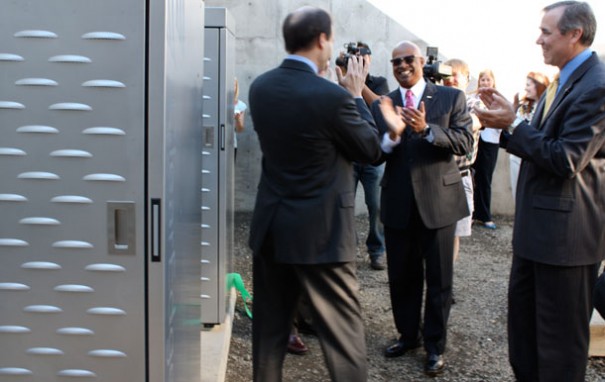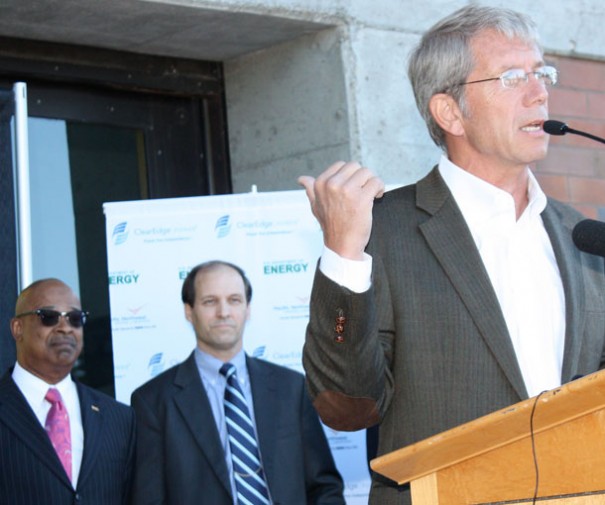This content was published: October 4, 2011. Phone numbers, email addresses, and other information may have changed.
PCC first college in country to use ClearEdge fuel cells
Photos and story by Gina Whitehill-Baziuk
The dignitaries came to Portland Community College’s Sylvania Campus in groups of two: Two members of Congress. Two state-of-the-art fuel cells. And a member each of the U.S. Department of Energy and Hillsboro-based ClearEdge Power, the maker of the cutting-edge fuel cells.
The Thursday, Sept. 29 press conference was the unveiling of the twin cells, which are providing power to Sylvania’s Health Technology Building and heat to that building’s swimming pool.
Dignitaries on hand included U.S. Sen. Jeff Merkley and U.S. Rep. Kurt Schrader, whose congressional district includes Sylvania.
“This project is very exciting,” said Preston Pulliams, district president of PCC. “It allows us to gain significant environmental benefits and create a living laboratory for students.”
The fuel cells are all part of an effort to retrofit Sylvania, PCC’s oldest campus, to make it more sustainable.
The fuel cells, called ClearEdge5, convert natural gas into electricity and heat. According to ClearEdge Power of Hillsboro, that makes the cells 10 times more productive than solar power and reduces a portion of the campuses carbon footprint.
Sen. Merkley has long been a proponent of sustainability. “With projects like this, Oregon is establishing the infrastructure to transform our economy and establish opportunities for future generations,” he said. “Portland Community College and ClearEdge are leading the way.”
PCC is the first college or university to activate a ClearEdge fuel cell, although others are expected to come online this year.
“Portland Community College is setting an example for colleges across the nation,” Rep. Schrader said. He pointed out that PCC is teaching a wide array of classes in sustainability, ranging from construction to automotive to wind and solar power. He said the college, “has an incredibly impressive alternative energy curriculum and the way it leverages alternative energy sources is also highly commendable.”
Other speakers at Thursday’s event included Russell Ford, president of ClearEdge Power, and Rick Farmer, deputy project manager and chief engineer for fuel cell technologies at the U.S. Department of Energy.
Pulliams said the retrofit of Sylvania is just one aspect of the college’s sustainability goals. Since the passage of a $374 million bond measure in 2008 – the largest successful bond measure for an educational institution in state history – the college has opened the Willow Creek Center, which is rated as LEED Platinum status – LEED is the internationally recognized measurement for energy-efficient buildings – and the Newberg Center, which is LEED platinum now but could surpass that when all systems are fully online. Construction at all three main campuses and PCC’s Southeast Center also will focus on sustainability.

PCC District President Preston Pulliams enjoys a moment with dignitaries at the ClearEdge fuel cell announcement on Thursday, Sept. 29. Participants applaud following the ribbon cutting. At left is one of the two now-operational fuel cells.
“With the ClearEdge Power systems, we will be able to support our sustainability goals and give our students the opportunity to see fuel cell technologies in action,” Pulliams said. “We also are proud to be part of a broader (Department of Energy)-supported project that will help demonstrate the incredible value of continuous power systems like the ClearEdge5 for colleges nationwide.”
Pacific Northwest National Laboratory will monitor PCC’s fuel cells during the next several years to confirm the energy-usage goals.

